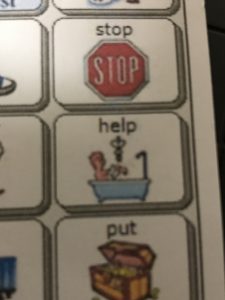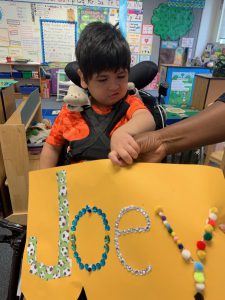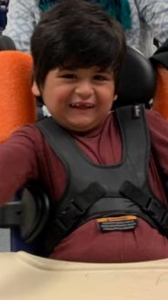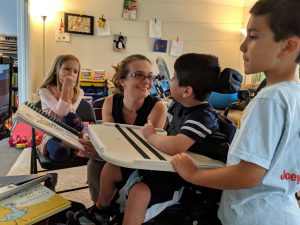 So often, people who use AAC to communicate find themselves caught in the ability to only communicate with those who understand how AAC devices work in situations where AAC devices are available. It can be a small world in which to communicate. And yet, those of us who are able-bodied are only currently able-bodied. It is not something any of us want to think about, but any of us are capable of one day relying on AAC supports in order to reach the world around us.
So often, people who use AAC to communicate find themselves caught in the ability to only communicate with those who understand how AAC devices work in situations where AAC devices are available. It can be a small world in which to communicate. And yet, those of us who are able-bodied are only currently able-bodied. It is not something any of us want to think about, but any of us are capable of one day relying on AAC supports in order to reach the world around us.
Somewhere in my quarantined on-line searches I stumbled upon this resource page from the Patient-Provider Communication Forum. The resources were developed by speech-language pathologists, nursing leaders, engineers, and with help from the U.S. Society of Augmentative and Alternative Communications. It provides pages of low-tech pictures that can be provided to people with COVID-19 who are unable to communicate.

 Right before the whole world shut down for the COVID-19, my daughter and Joey’s older brother were home from school so they both participated in my session with Joey. My daughter was thrilled to get to see Joey again and read the high frequency words along with him. I think Joey’s older brother may have been happier to have not joined our group of kindergarteners, but he was a huge help regardless.
Right before the whole world shut down for the COVID-19, my daughter and Joey’s older brother were home from school so they both participated in my session with Joey. My daughter was thrilled to get to see Joey again and read the high frequency words along with him. I think Joey’s older brother may have been happier to have not joined our group of kindergarteners, but he was a huge help regardless. I found myself getting nervous before my opportunity to present the research on Joey’s progress at the Council for Exceptional Children’s DADD conference in January. Joey’s journey is unique, but as I scrolled through my prepared slides I wondered if I was on the right track. So much of my work with Joey has involved throwing off what I was taught in terms of behavioral approaches and meeting Joey where he asks to be met. Not what I plan for Joey to do, or what I’ve done with students in the past, but where Joey shows me he is ready to work. Although this is the right approach for Joey, and I truly believe in the approaches we take for him, I realized I was nervous about the response I would get. Sometimes it just feels too different than the otherwise straightforward approaches to teaching communication. The audience of this conference included many doctoral degrees and experts in the field. What if I was doing everything wrong, and everyone heard me say it aloud?
I found myself getting nervous before my opportunity to present the research on Joey’s progress at the Council for Exceptional Children’s DADD conference in January. Joey’s journey is unique, but as I scrolled through my prepared slides I wondered if I was on the right track. So much of my work with Joey has involved throwing off what I was taught in terms of behavioral approaches and meeting Joey where he asks to be met. Not what I plan for Joey to do, or what I’ve done with students in the past, but where Joey shows me he is ready to work. Although this is the right approach for Joey, and I truly believe in the approaches we take for him, I realized I was nervous about the response I would get. Sometimes it just feels too different than the otherwise straightforward approaches to teaching communication. The audience of this conference included many doctoral degrees and experts in the field. What if I was doing everything wrong, and everyone heard me say it aloud? I have spent the last few hours analyzing Joey’s data over the last year and looking at trends and patterns. I have the opportunity to present Joey’s journey and the data of his progress at both the
I have spent the last few hours analyzing Joey’s data over the last year and looking at trends and patterns. I have the opportunity to present Joey’s journey and the data of his progress at both the  I opened the door to Joey’s house and found him waiting for me at his device. He looked at me, grinned, turned back to his computer, and said “Hi Miss Ann-Bailey. My name is Joey.” I can’t tell you how exciting it was to hear him say my name – and based on the grin on his face, it seemed like he was pretty excited to say it too.
I opened the door to Joey’s house and found him waiting for me at his device. He looked at me, grinned, turned back to his computer, and said “Hi Miss Ann-Bailey. My name is Joey.” I can’t tell you how exciting it was to hear him say my name – and based on the grin on his face, it seemed like he was pretty excited to say it too.
